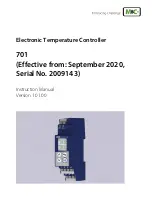
21
Description of the display elements
Here, the current number in the seed library as
well as the name of the seed type are shown. If
a name has not yet been assigned, the seed type
can be named or renamed here.
Here, the desired spread rate in kg/ha is set.
If you want to perform the calibration test in
seeds/m², you must set the desired number of
grains per square meter, the thousand grain
weight and the germination capacity.
Here, the working width of the mounted
implement is set.
Note:
deduct any overlaps from the working
width!
Here, the forward speed is set. If you are working
with a speed sensor, the average working speed
is entered.
Here, the utilised seeding shaft is set. This is
saved in the seed library along with the seed
type.
When calling up the seed type again, it must be
ensured that the stored seeding shaft is used
again; otherwise, the calibration test must be
repeated.
Here, the desired calibration time (0.5 min, 1 min
or 2 min) or area (1/40 ha, 1/20 ha, 1/10 ha) can
be set. When selecting an area, the calibration
time will be automatically calculated and
displayed.
When using a calibration button (available as an
accessory), this point is hidden.
CAUTION!
If values are changed in the Calibration menu, a new calibration test must be performed.
TIP!
For small seed types (e.g. canola, phacelia, poppy, etc.), a calibration time of 2 minutes is
recommended. For larger seed types (e.g. wheat, barley, peas etc.), a calibration time of 0.5
minutes is enough.
If the implement type PS TWIN is selected in the basic settings menu (see Point 5.2), the additional
information given in Point 7.2.1 must also be observed.
If the implement type LF600 is selected in the basic settings (see Point 5.2), a calibration test is not
required. Here, proceed according to Point 8.
Summary of Contents for ISOBUS M2
Page 54: ...54 NOTES ...
Page 55: ...55 NOTES ...
















































